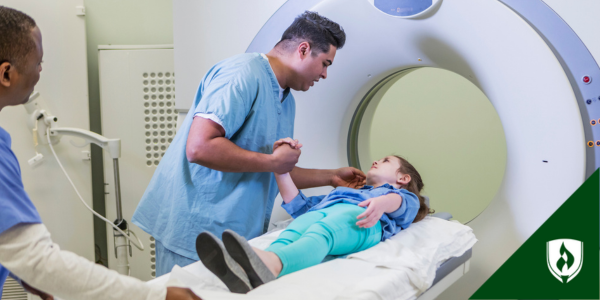Radiologist vs. Radiologic Technologist: Illuminating the Differences
By Brianna Flavin on 04/16/2024

If you’re looking to get established in a more substantial and reliable career, it’s easy to understand the appeal of the growing healthcare field. Healthcare professionals can count on being needed pretty consistently in most places throughout the country.
Afterall, people will always need healthcare. And unlike many other industries, healthcare becomes even more important during times of national crisis (looking at you, 2020).
There are quite a few solid career options in this field. But if you are interested in radiology, you can narrow things down a little. Radiology is all about using forms of radiation to capture images inside the human body and interpreting those medical images to evaluate and diagnose.
But, even for careers inside radiology, there are choices to make.
Radiologists, radiology technologists and even radiology nurses all call this specialty home.1
How can you know which type of radiology career is best for you? What’s the difference between a radiologist and a radiologic technologist?
Read on! There are major differences in these career paths, even though they both wind up in the same section of the hospital.
Radiologist vs radiology tech: The basics
The most critical difference between these careers in the medical specialty of radiology is that radiologists are medical doctors who can interpret and diagnose medical images—and radiology techs are associate-degree-level professionals trained in imaging tests, procedures and equipment.
Basically, a radiologic technologist operates the medical imaging equipment, takes the x ray, CT scan or MRI, and a radiologist interprets diagnostic images to make a medical diagnosis.
Radiologist vs radiology tech: Job responsibilities
A radiologist is a medical doctor (MD) or doctor of osteopathic medicine (DO) who reviews medical images to diagnose medical conditions. They concentrate their medical training on the specialty of radiology and sometimes a specific subspecialty of radiology like pediatric radiology, nuclear radiology or cardiovascular, gastrointestinal or musculoskeletal radiology—to name a few options.
Additionally, certain subspecialties like interventional radiology or radiation oncology also involve the direct treatment of patients.
Often, these doctors are working in concert with other physicians. Once they interpret diagnostic images, they’ll communicate their findings to the patient’s ordering doctor who will then take over the case for treatment.
Some of the main duties of a radiologist are to...2
- Consult with a referring physician, advising them in which examinations to choose
- Interpret the outcomes of diagnostic imaging procedures and correlate results with other exams and tests
- Coordinate with other health care professionals to create a treatment plan
- Direct and oversee radiologic technologists
“A radiologic tech (sometimes called 'rad tech') is a trained imaging technologist who works in a radiology department in one or more modalities, or imaging specialties,” says Laura Horton, a clinical specialist sonographer.
This role requires direct patient interaction as well as knowing how to operate and maintain highly technical specialized equipment. Rad techs also need to follow safety protocols since they work with radiation.
Some of the main duties of a radiologic technologist are to...3
- Adjust, maintain and operate the medical imaging equipment (x ray machines, CT scanners and more)
- Work with patients by taking a medical history, positioning the patient and the equipment in order to get the correct image, and shielding exposed areas that do not need to be imaged
- Keep detailed patient records
- Work with physicians to evaluate the images and determine whether additional images need to be taken
If you are especially interested in a certain aspect of the human body, a certain demographic (like working with kids or the elderly) or even certain parts of radiation technology, you can specialize! Some specialties rad techs can pursue following their core education and training are...
- Mammography
- Sonography
- Nuclear medicine
- MRI technology
- Bone densitometry
- Computed tomography
- Fluoroscopy
For more about these, check out 7 Radiology Specialties That Go Beyond X-Rays.
Radiologist vs radiology tech: Education requirements
As you might expect, there’s quite a difference in education between a doctor and a technologist.
Radiologists are licensed physicians with a specialty in radiology, so they need to attend medical school. The education process, according to the BLS (Bureau of Labor Statistics) typically looks like:4
- A four year undergraduate degree
- Four years of medical school
- A residency program specializing in radiology
All said and done, it can take eight to 12 years to become a radiologist.3
Education for a radiologic technologist is much shorter—the Radiologic Technology Associate’s degree program at Rasmussen University can be completed in as few as 24 months.5
Pair this education with professional certification through The American Registry of Radiologic Technologists®, and you’ll be ready to start applying for positions. That said, licensure requirements are not uniform across all states, so make sure you understand the requirements of the state in which you wish to practice.
Though the educational requirements differ, both careers require time, effort and precision in their work. The right image and corresponding diagnosis can be the difference between life and death for patients.
Radiologist vs radiology tech: Job outlook
Radiologists have a steady job outlook, with employment of all physicians projected to grow at the average rate of 4 percent from 2022 through 2032.6
Interestingly enough, the job outlook for radiologic technologists is twice as bright. The BLS projects a 5 percent growth in employment from 2022 through 2032, a rate faster than the national average for all occupations.2
Radiologist vs radiology tech: Important qualities
Both radiologists and rad techs should be interested in technology and patient care. However, some personalities may find a better fit in one job over the other.
Radiologists need plenty of determination and commitment since they’ll need lots of education to enter the field. Beyond possessing the extensive medical knowledge of a physician, radiologists also need to be strong communicators and team players.
“The best radiologists discuss cases with you [as a rad tech] and recognize that we are a team,” Horton says.
Radiologic technologists also need collaborative skills, along with great active listening skills since they have a more patient-facing role than radiologists. Medical professionals who choose this role need to have empathy and respect for others. Imaging procedures can be scary or stressful for patients. Whether you work with a child terrified of the massive MRI machine or an adult terrified of finding out they have cancer, the odds are high that you will work with patients in moments of real vulnerability.
They also need to be good at taking direction from others and taking ownership of their work.
Which career will you choose?
Now that you better understand the differences between these two common radiology-focused careers, you can make an informed decision about which career path is best for you. Your personality, career expectations and the length of time you’re willing to spend in school are all factors you’ll want to consider as you weigh your options.
If you think becoming a radiologic technologist is right for you, check out “How to Become a Radiologic Technologist: Examining Your Path.”
The American Registry of Radiologic Technologists® is a registered trademark of The American Registry of Radiologic Technologists.
1To become a Radiologist you must complete extensive education and training involving undergraduate education, medical school, residency and more. Rasmussen University does not offer any programs that will lead to this career opportunity.
2RadiologyInfo.org, What does a radiologist do?, (accessed April 2024), What does a radiologist do? (radiologyinfo.org).
3Bureau of Labor Statistics, U.S. Department of Labor, Occupational Outlook Handbook, Radiologic and MRI Technologists, (accessed April 2024) Radiologic and MRI Technologists : Occupational Outlook Handbook: : U.S. Bureau of Labor Statistics (bls.gov) Information represents national, averaged data for the occupations listed and includes workers at all levels of education and experience. Employment conditions in your area may vary.
4Bureau of Labor Statistics, U.S. Department of Labor, Occupational Outlook Handbook, Physicians and Surgeons, (accessed April 2024), Physicians and Surgeons : Occupational Outlook Handbook: : U.S. Bureau of Labor Statistics (bls.gov)
5Completion time is dependent on the number of transfer credits accepted and the number of courses completed each term.
6Bureau of Labor Statistics, U.S. Department of Labor, Occupational Outlook Handbook, Physicians and Surgeons, (accessed April 2024), Physicians and Surgeons : Occupational Outlook Handbook: U.S. Bureau of Labor Statistics (bls.gov). Information represents national, averaged data for the occupations listed and includes workers at all levels of education and experience. Employment conditions in your area may vary.
EDITOR’S NOTE: This article was originally published in 2017. It has since been updated for 2024.




.jpg)